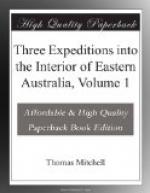That active and enterprising officer reached the Gwydir in latitude 29 degrees 27 minutes 37 seconds South, longitude 150 degrees 5 minutes East. Tracing upwards its course, or a branch of this river, he arrived near the western extremity of the Nundewar range, and ascended the hill named by him Mount Albuera. Being accompanied by a native of Bathurst, he ascertained that the aboriginal name of the singular-looking hill forming the western extremity of that range was Courada (the name of The Barber’s burning mountain) and his plains of Ballyran were found to be those crossed by my party in returning from Snodgrass Lagoon.
This journey of discovery proved that any large river flowing to the north-west must be far to the northward of latitude 29 degrees. All the rivers south of that parallel, and which had been described by The Barber as falling into such a river as the Kindur, have been ascertained to belong wholly to the basin of the Darling.
The country we traversed was very eligible in many parts for the formation of grazing establishments, as a proof of which it may be mentioned that flocks of sheep soon covered the plains of Mulluba, and that the country around The Barber’s stockyard has, ever since the return of the expedition, been occupied by the cattle of Sir John Jamieson. At a still greater distance from the settled districts much valuable land will be found around the base of the Nundewar range. The region beyond these mountains, or between them and the Gwydir, is beautiful; and in the vicinity, or within sight, of the high land, it is sufficiently well watered to become an important addition to the pastoral capabilities of New South Wales.
...
METEOROLOGICAL JOURNAL KEPT DURING THE EXPEDITION TO THE NORTH-WEST, AND COMMENCED ON CROSSING LIVERPOOL RANGE, DECEMBER 5, 1831.
COLUMN 1: DATE.
COLUMN 2: WINDS, A.M.
COLUMN 3: WINDS, P.M.
COLUMN 4: CLOUDS, A.M.
COLUMN 5: CLOUDS, P.M.
COLUMN 6: THERMOMETER (IN THE SHADE), SUNRISE.
COLUMN 7: THERMOMETER (IN THE SHADE), NOON.
COLUMN 8: THERMOMETER (IN THE SHADE), 4 P.M.
COLUMN 9: THERMOMETER (IN THE SHADE), SUNSET.
COLUMN 10: REMARKS.
December: 5 : North-west : North-west : Clear : Clear : 70 : 96 : 94 : 86 : Hot wind. 6 : — : North-North-west : — : — : 64 : 95 : 98 : 90 : -. 7 : — : North-west : Cirrus : Nimbus : 84 : 92 : 96 : 84 : A.M., sultry, P.M., thunder and showers. 8 : Calm : South-South-East : Cirro-cumulus : Sky clear : 68 : 81 : 90 : 78 : — PM., sultry. 9 : — : North-east : Clear : Clear : 60 : 89 : 90 : 88 : Towards evening the wind unsettled. 10 : West-South-West : South : Nimbus : Rain : 70 : 68 : 66 : 64 : In the morning cloudy, rain in the afternoon. 11 : Light North-North-East : South-South-West : Cumulus : Clear : 63 : 79 : 78 : 75 : Fine during




